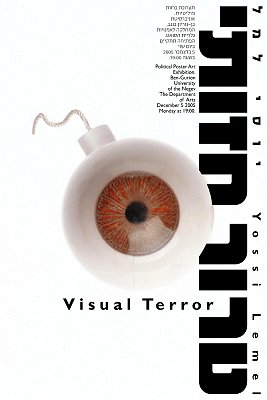
Exhibition poster by Yossi Lemel
The Senat Gallery
Beer Sheva University of the Negev, Beer Sheva, Israel
The Department of Arts
Opening at 19:00
December 5 2005-March 26 2006
Yossi Lemel: Visual Terror
Do artists in an "era of terror" opt for paralysis, like a snail hiding in its art shell, or do they accept responsibility, voicing protest through their art - art against TNT?
Yossi Lemel, an artist and designer, harnesses a well known format - the street poster - to articulate the sane human voice and point at the possibilities of conscious and practical change. The street poster, to which we are exposed consciously and unconsciously, enables him to introduce powerful, uncanny, provocative visual images which endeavor to strike and awaken one's awareness. One may call this "visual terror" (as the title of the exhibition), although this type of "terror" should be distinguished from actual, injuring and deadening terror.
A distinction in this vein is made by art scholar Boris Groys, who maintains that a terrorist struggle is an effective struggle to occupy the media, a fight for the news. Art, like terror, faces risks, but unlike the terrorist, the artist endeavors to expose his acts. According to Groys, we are familiar with Bin Laden only as a video-producing artist: "We don't know whether he is a terrorist or not, but we do know for certain that he is a video artist [producing] efficient totalitarian aesthetics." Groys further asks and replies: "What is totalitarian art? It is a mere advertisement, yet one without a product, a self-advertising advertisement. [Bin Laden] produces awe toward some mastery over spiritual consciousness, an expectation of something spectacular, albeit unknown. It markets itself."*
It is against this backdrop that Yossi Lemel's posters should be examined, posters that respond to terror's multiple faces in the past and present. They contain acute, piercing statements against the horrors of World War II (Holocaust, Hiroshima); against racism, xenophobia, violence, political assassination, and denial of human rights (Amnesty); against the terror of the Israeli-Palestinian conflict; against inter-national terror (9/11), etc. His sensitivity and responsibility towards the issues he addresses, he says, should also be credited to his being the son of Holocaust survivors who infused him with a socio-political consciousness and the understanding that the command "To Remember and Never Forget" refers not only to the historical boundaries of the "Jewish Holocaust", but also to being constantly alert to any human wrongdoing that might lead to another holocaust. In his poster for the 50th anniversary of Hiroshima's atomic bombing he wrote: "We don't need another Hiro". This statement seems to encapsulate the essence and core of the response: in opposition to the "axis of evil" and the paths of fear offered by terror, art situates itself as a proposal to transpire along the ethics/aesthetics axis.
Prof. Haim Maor
Curator of the exhibition